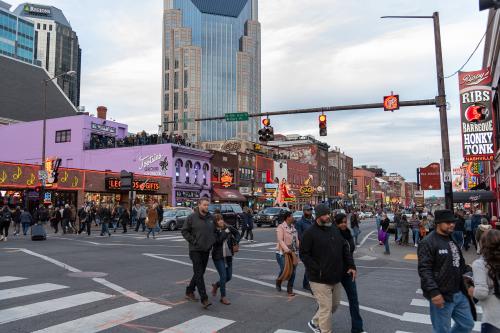Thirty years ago, some futurists predicted that the restructuring of the American economy and our technological advances would free and un-anchor us from place, precipitating a mass de-urbanization throughout the nation.
Well, they were wrong. Far from being dead, cities are experiencing a second life, fueled, in part, by their distinctive physical assets: mixed-use downtowns, pedestrian-friendly neighborhoods, adjoining rivers and lakes, historic buildings and distinctive architecture.
An astonishing 83 percent of the American population lives in metropolitan areas which, together, drive and dominate the economy and house our wealth-generating industries, our centers of research and innovation, our ports of commerce and our gateways of immigration.
The American economy has evolved into a series of clusters — networks of firms that engage in the production of similar products and the provision of similar services. And firms within these clusters crave proximity to pools of qualified workers, to specialized services like legal or finance that often require face-to-face interaction, to infrastructure that enables mobility of people and goods, to other firms so that ideas and innovations can be rapidly shared. Density — the essence of urban places — matters even more in the knowledge economy than it did in the industrial economy.
The Washington region is no exception, and, in fact, is an avatar of the trends reshaping the nation.
The District has rebounded from population loss and can now boast a 24-7 downtown that is a magnet for young professionals, tourists and suburban residents. The region’s economy has been on a two-decade upswing, attracting high-end service and technology firms and bolstering existing industries, which in turn have created construction and other service jobs.
Together, this job growth has created demand for more skilled workers, including immigrants. And density has long become a reality in Arlington, Fairfax, Montgomery and Prince George’s counties and is emerging in outlying jurisdictions.
But for all their assets and dominance, the D.C. region and other leading metro areas face myriad challenges that must be overcome for them to leverage their boundless opportunities. Yet they cannot solve these challenges by themselves; they need the support of higher powers, national not divine, to thrive over the long term.
However, for too long, national efforts to bolster metropolitan America — including Washington — have been piecemeal, created in isolation without regard to their impacts upon other goals.
Low-income housing is built overwhelmingly in poor, inner-city neighborhoods, and we wonder why these places remain intractably mired in poverty. Meanwhile, many of the entry-level jobs that serve as a ladder to the middle class have moved to the suburbs.
Here, the federal decision on military base realignment was made with little regard to the impacts on housing, transportation, schools and the provision of access to jobs.
If Washington and other metro areas are going to grow high-road, productive economies, we need strategic federal and state investments in science and technology, advanced research and innovation as well as support for small-business growth: health care, capital access and entrepreneurial support.
If metro areas are going to grow in sustainable ways, we need smart federal and state policies on transportation, housing, land reclamation and energy efficiency — and a market-shaping commitment to environmental sanity that reduces our carbon contribution to climate change. If metro areas are going to grow a strong middle class, we need a federal and state commitment to improve access to quality education at all levels and to increase the supply of housing that is affordable to our workforce so they can live near their jobs.
The Washington region is already advancing on some of these goals — from reclaiming the Anacostia waterfront, developing transit in the edge city of Tysons Corner and instituting green technology in the District and some surrounding counties.
But more can be done to ensure that this vibrancy benefits more of the region’s residents.
Washington, because of its unique relationship with the federal government, could and should be a test case of what a holistic federal policy to strengthen metropolitan America could look like.
Overall, as we approach the presidential election, the United States needs a national agenda — a blueprint for national prosperity — to give cities and metro areas the rules and the tools to leverage their economic assets and prosper.
This blueprint must respect the central lesson of our time: that the ability of our nation to compete globally and meet the great environmental and social challenges of our time rests largely on the health and vitality and prosperity of major cities and metropolitan areas like Washington.
We are, in short, a full-fledged “Metro Nation”; it is high time to start acting like one both here and nationally.


Commentary
Op-edA Much More Urban America
July 23, 2007